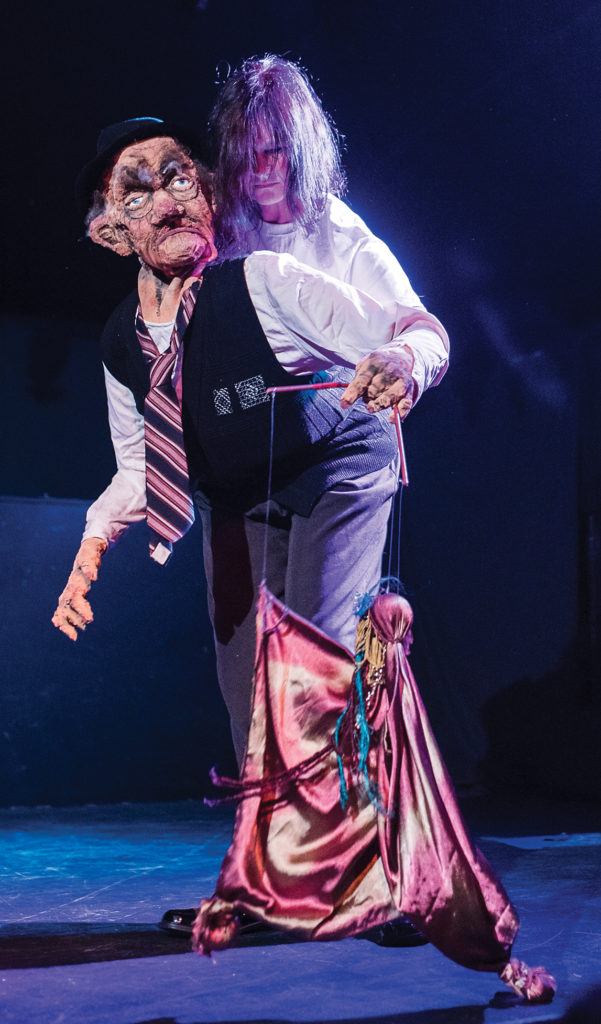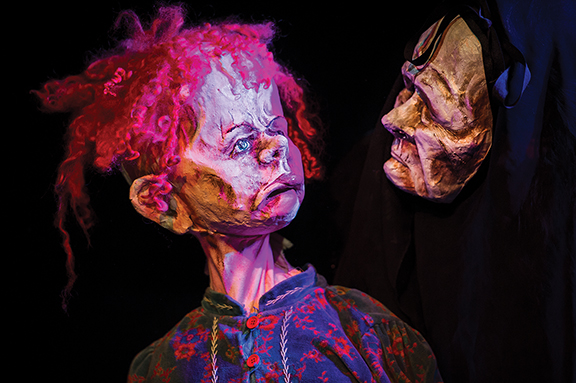Meinjsa Vlaming fell in love with puppeteering when she was 18-years-old. To be more specific she fell in love with a handsome puppeteer.
“He was so amazing and beautiful but he had no idea who I was because he already had stage shows and everything,” she said.
Vlaming had been making puppets since she was nine years old, using a pattern,that she still uses today, that she got from a TV show .
Around the same time she was pining for the puppeteer, she saw the movie Les Enfants du Paradis. She was enchanted by the masks and grotesque movements of the comedia dell’Arte group. And so she decided she wanted to be a puppeteer.
But she went about it the wrong way. “I thought I needed other people,” she said.
“Life is too short not to do what you love.”
So on top of teaching yoga and working for a fly-over photography company in the Netherlands, Vlaming and two friends began making marionettes. However, that didn’t go anywhere. One friend wanted to do a Monty Python-esque puppet show, which was not what Vlaming had in mind and the other friend fell in love and got married.
And so Vlaming moved on to dollmaking. In 1985, Vlaming travelled to Canada on holidays. Her friends back home bet a case of beer that she wouldn’t return one and a half months later like she had planned. They were right. Vlaming met a man in Lund, B.C. and sold her return ticket. She returned home pregnant six months later.
For three years she made trips back and forth before the getting married and officially becoming a landed immigrant. The couple had two more kids together before getting divorced ten years later.
While raising her kids, Vlaming’s only puppets were made of napkins in restaurants to keep the little ones quiet. She taught art classes at her kids’ school for awhile, marionettes being one of the projects, but her personal art journey took her in other directions.
Vlaming made costumes for the school plays. She made jewellery.
At one point she studied colour theory but had no intention of learning to paint.
 “I don’t need something else that I am passionate about that doesn’t make me money,” she said. But, inevitably is seems, she fell for painting as well.
“I don’t need something else that I am passionate about that doesn’t make me money,” she said. But, inevitably is seems, she fell for painting as well.
Soon it wasn’t just creating with her hands, Vlaming got involved with dance as well. It started with Middle Eastern Dancing. She worked both as a dancer and as a teacher. Because of previous injuries, belly dancing became too difficult so Vlaming turned to zambra, which is a combination of Flamenco dancing and belly dancing.
Vlaming teaches a troupe from Cortes Island. They performed at the River City Arts Festival in July.
For a five year stint Vlaming ran a restaurant on Cortes, but she didn’t have time for art and she was miserable.
“Life is too short not to do what you love,” she said.
At the moment dance, as well as puppetry are what keep Vlaming, who is quickly approaching 60, busy.
“I would never retire, what would I do?” she said. “People that retire pick up painting.”
Thirty-seven years after falling in love with the puppeteer, Vlaming got back into making puppets.
She was looking at her dolls one day, and decided two things, first that she didn’t like that they were stationary, and second that she would like to find a way to become one of her dolls.
Vlaming said that puppetry is a combination of all of the art she has created in her life, stitching, sculpting, painting and performing, it has all come together, coincidentally, in the very same place where it started.
Looking back, Vlaming said the first puppet that she made wasn’t very good. She attempted to make a muppet type character using pop bottles and covering them with felt. At the same time Vlaming created scarf marionettes, which have strings attached to their heads and hands and if their hands move, their feet move. She also made sock puppet type characters with the mouth, eyes and nose situated on her fist.
Though it started off fairly simply, it grew from there. Vlaming has taken workshops both on Quadra and once every couple years in Banff to learn how to make puppets as well as the history and technique behind good puppetry.
Vlaming now has a variety of characters that she takes out to parties, festivals and parades.
Some of her puppets are hand puppets, she controls their mouth with one hand and their limbs with the other. When more flowy movements are required of celestial type characters they are often marionettes. Some of her more wacky puppets are hybrid puppets. They are nothing but a torso. Vlaming uses her own legs as their lets and controls their mouth with one hand her arm is one of their arms.
What Vlaming doesn’t want is to be a puppeteer dressed in black or controlling puppets from strings, she wants to be on stage interacting with her puppets. That call to the stage is something she thinks she inherited from her mother.
Though on stage with her puppets, many of Vlamings shows are lip synced. She creates a loop and her and her puppets talk, sing and perform along with it.
“If I look at one big red thread in my work it is expression,” she said. “With the expression I try to evoke emotions. That’s what all my art boils down to. When we have emotions we feel like we are alive, like we are really really alive.”
At the end of July she was working on her interpretation of The Velveteen Rabbit. An idea that came to her when her daughter got sick and asked for a story to help her feel better. She said that much of her other inspiration comes from music. A song will inspire the free thinking that leads to choreography as well as puppets.
At one point Vlaming wished it hadn’t taken her so long to get back to puppetry.
“I would have been brilliant by now,” she said.
But it wouldn’t have been the same. Sometimes you need to walk your road and pay your dues.
“I’m happy with the way it all went,” she said. “Everything I have done was with so much love.”
